16 Best Note-Taking Apps for Student
Sep 24, 2025
Keeping up with lectures, assignments, and study materials can get overwhelming, especially when your notes are all over the place. If you’ve ever missed something important because you couldn’t find that one page in your notebook, you’re not alone. The good news is, some apps can help you stay organised without making things harder. Whether you’re someone who likes to scribble quick thoughts, record voice notes, or neatly organise every topic, there’s an app that fits your style. In this blog, you’ll find note-taking apps that actually work for students and make studying a little less stressful.
16 Top Note Taking Apps for Students
Category | App | Compatibility | Pricing | Best For |
|---|---|---|---|---|
AI-Powered Note-Taking Apps | Audionotes | Web, iOS, Android, Chrome extension | Personal: $69.99/year; Pro: $129.99/year | Automated lecture capture; AI-generated study notes |
Otter.ai | Web, iOS, Android | Basic: Free; Pro: $8.33/month billed annually or $16.99/month; Business: $20/user/month (annual) or $30/month | Live transcription, AI summaries, integrations | |
Notta.ai | Web, iOS, Android, desktop | Free: 120 min/month; Pro: $8.17/month (billed annually) (~$99/year); Business: $16.67/month (annual) | Real-time transcription, summaries, translations | |
Granola | Cross-platform (web/app) | Free trial: 25 meetings; Individual (Pro): $18/month; Business: $14/user/month; Enterprise: from $35/user/month | Meeting capture, clean AI summaries | |
Google NotebookLM | Web | Free basic version; NotebookLM Plus via Google One AI Premium around $14–$22/month | Synthesizing Docs/PDFs into summaries & flashcards | |
Genio (formerly Glean) | Web & apps | Approx. £12/month (~$15/month) per license | Lecture capture with structured annotation tools | |
Structured, Database-Style | Notion (Education Plus) | Web, mobile, desktop | Education Plus: Free for students/teachers; Plus plan (non-education): $10/user/month (annual) or $12/month (monthly) | Research, planners, collaboration workflows |
Obsidian | Win, Mac, Linux, iOS, Android | Core app: Free; Sync: $4/month (annual) or $5/month (monthly); Publish: $8/month/site | Local Markdown vault, privacy-focused knowledge base | |
Microsoft OneNote | Web, desktop, mobile | Free, included with Microsoft 365 subscriptions | Hierarchical note organization, collaboration | |
Evernote | Web, desktop, mobile | Free limited plan; Personal: $14.99/month or $129.99/year; Professional: $17.99/month or $169.99/year | Web clipping, tagging, robust search features | |
Simple, Distraction-Free | Apple Notes | iPhone, iPad, Mac, Web | Free | Built-in, minimal, transcription features |
Simplenote | Cross-platform | Free | Ultra-light text notes with sync | |
Bear | iOS, Mac | Free limited version; Pro: $2.99/month or $29.99/year | Elegant markdown, focus mode | |
Google Keep | Web, iOS, Android | Free | Quick notes, reminders, voice transcription | |
Zoho Notebook | iOS, Android, Mac, Windows, Web | Free; Pro plan approx. $19.99/year | Visual notecards, offline access | |
Standard Notes | Cross-platform & Web | Free; Productivity/Professional paid tiers (pricing varies) typically around $9.99–$12/month | Encrypted, privacy-first notes |
1. Audionotes – Best AI-Powered Note-Taking App for Students
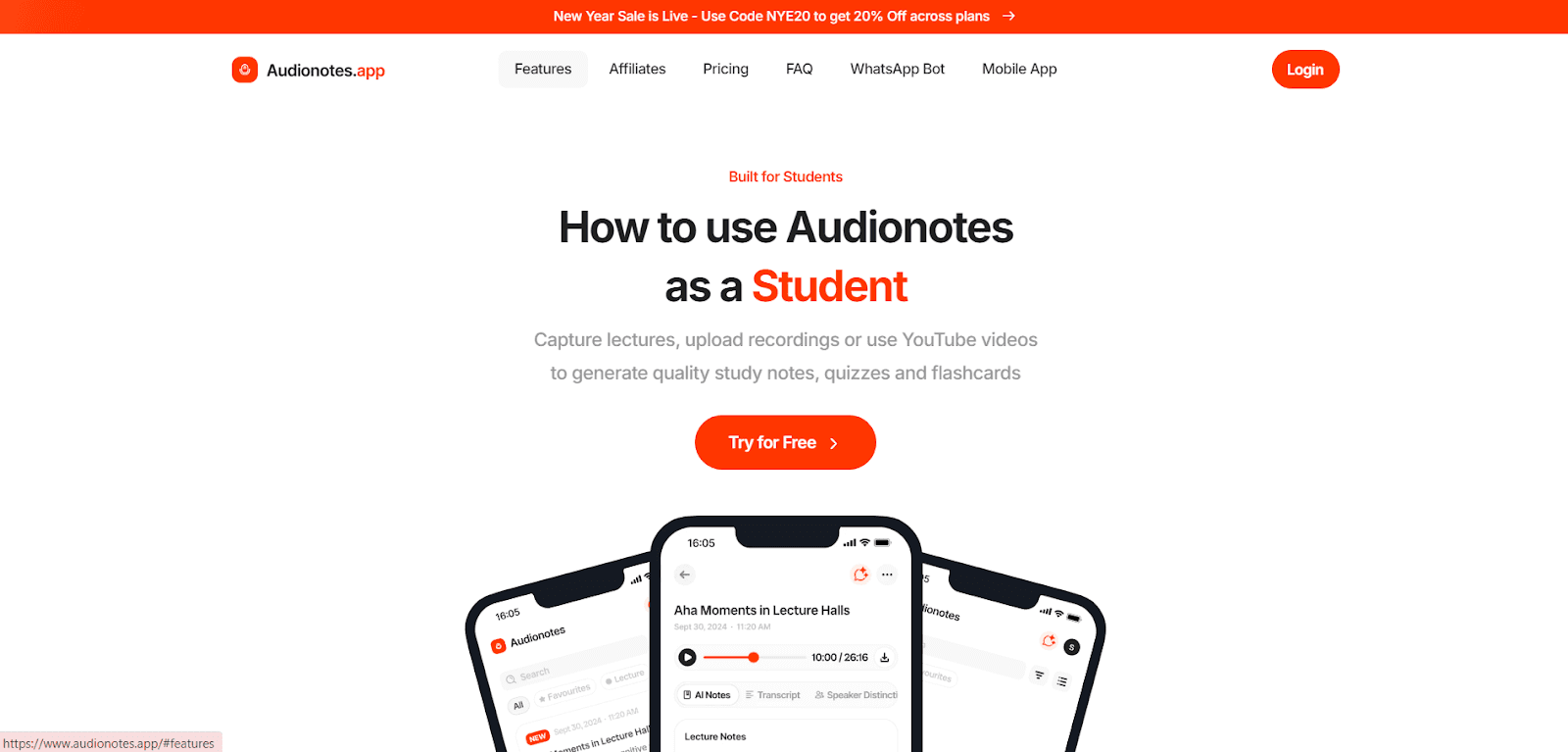
Audionotes is a cutting-edge AI-powered note-taking app designed specifically for students who want to automate and streamline their study process. It allows students to record lectures, transcribe audio, and generate structured study materials without manually taking notes.
Whether capturing live lectures, uploading recordings or extracting content from YouTube videos, Audionotes ensures that students always have accurate, well-organized notes ready for revision.
Key Features:
Lecture Recording & Transcription: Captures and transcribes live lectures, voice recordings, and YouTube videos into structured notes.
AI-Generated Summaries: Creates concise lecture summaries with key takeaways for quick revision.
Flashcards & Quizzes: Converts study materials into interactive flashcards and quizzes to reinforce learning.
Essay & Assignment Assistance: Generates well-structured essays, assignments, and study guides from dictated notes or text inputs.
Multilingual Support: Transcribes and translates notes in 30+ languages, making it accessible for international students.
AI Chat with Notes: Allows students to search within their notes and chat with them to get answers, clarify concepts, and explore key points in depth.
Seamless Integrations: Syncs with WhatsApp, Notion, and Zapier to automate workflows and keep study materials organized.
Custom Output Prompts: Provides pre-set AI prompts or allows custom queries to generate summaries, articles, and structured study notes.
Best For
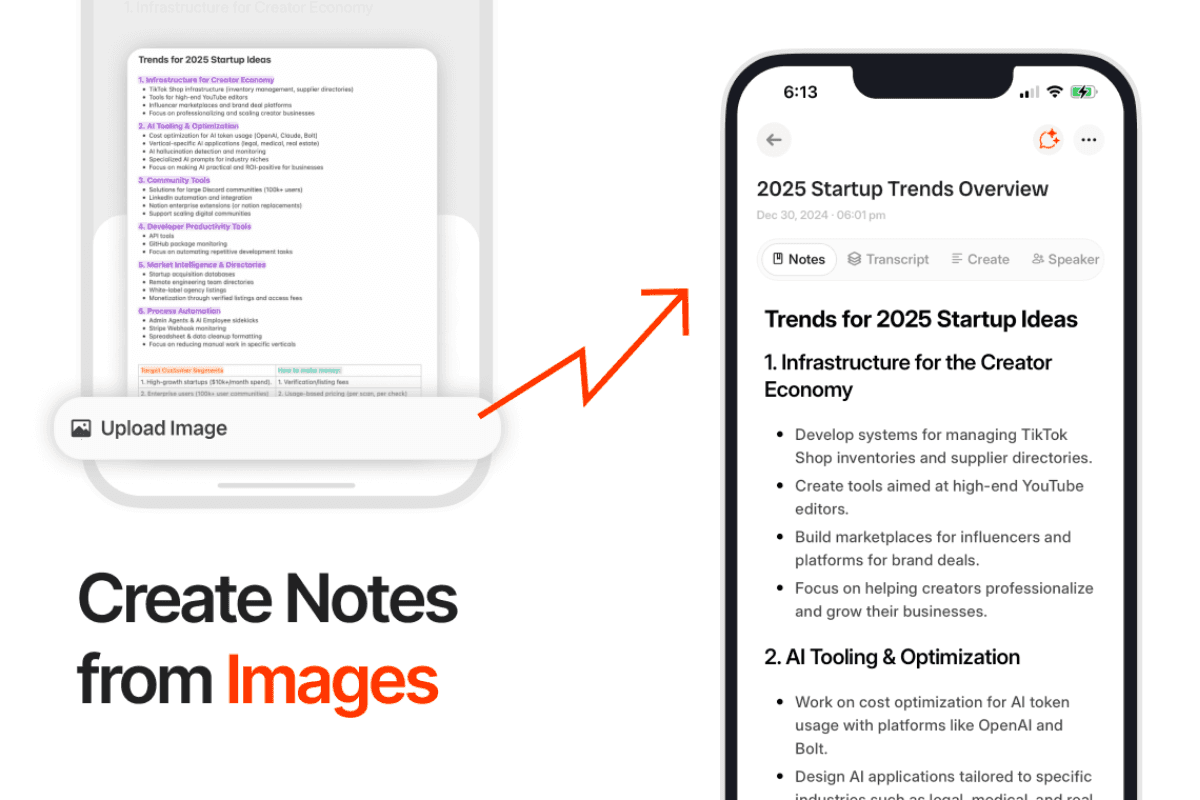
Students who struggle to keep up with fast-paced lectures and need automated note-taking.
Students with ADHD who benefit from structured, AI-powered study tools for better focus and organization.
Those who want a structured, AI-assisted way to revise, with features like flashcards, quizzes, and study guides.
Students who prefer multimodal learning through audio, text, images, and interactive study tools.
Cons
The app's extensive features may create a steep learning curve for some students.
Personal Plan: $9.99/month
Pro Plan: $19.99/month
AudioNotes is available on Android, iOS, and the web, so you can use it wherever it suits you best.
2. Microsoft OneNote – Best for Digital Notebook Organization
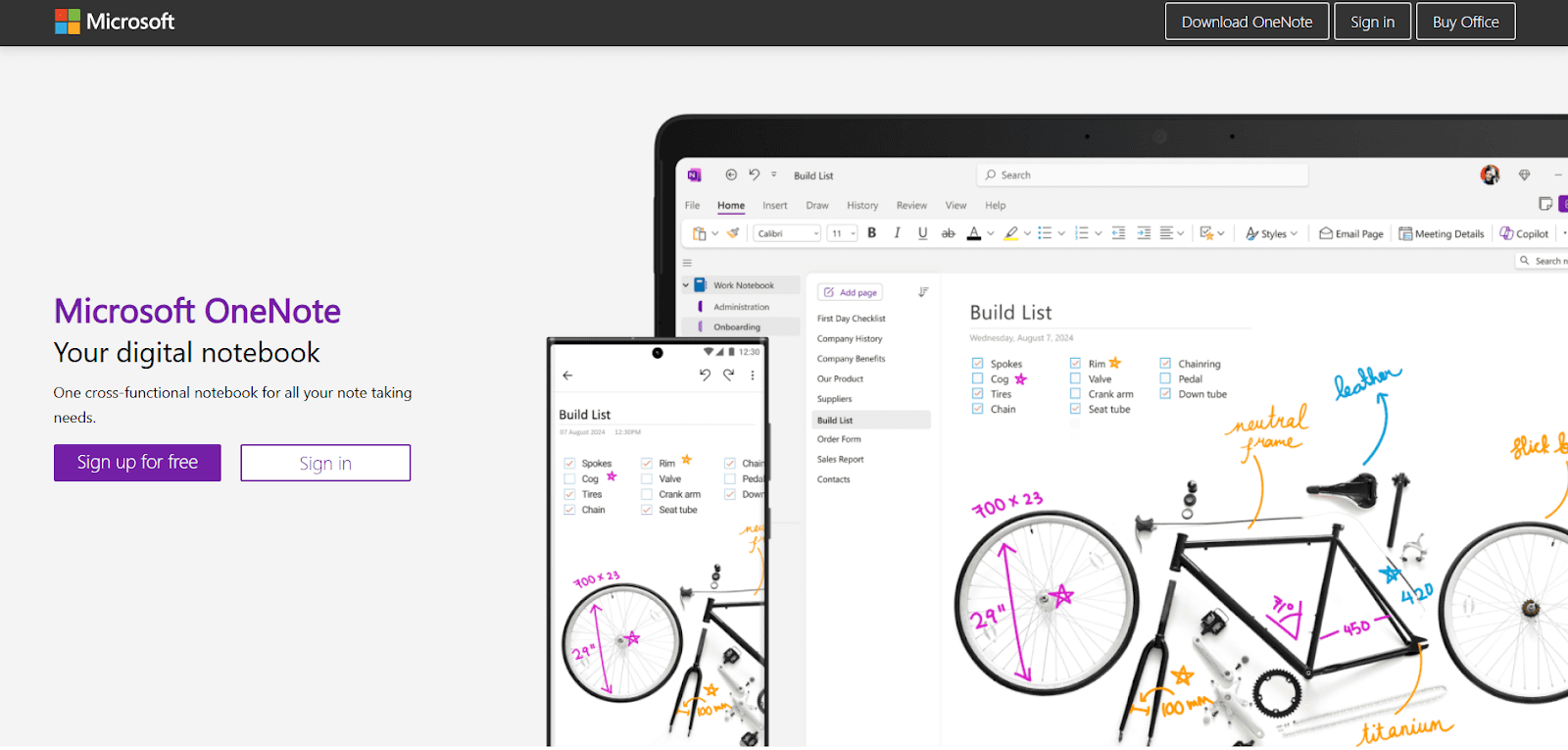
Microsoft OneNote is a digital notebook-style note-taking app designed to mimic the experience of a physical notebook. It allows students to organize notes by subject, section, and page, making it easy to keep track of different topics. With support for handwritten notes, multimedia integration, and cross-device syncing, OneNote is a flexible tool for students who need structured organization in their note-taking.
Key Features
Notebook and section-based organization: Divides notes into structured topics, making it easier to manage different subjects.
Handwritten notes support: Allows stylus input, making it ideal for writing equations, drawing diagrams, and annotating notes.
Immersive Reader mode: Reads notes aloud, improving accessibility for students with learning needs.
Syncs across devices: Works on Windows, macOS, iOS, and Android, ensuring notes are accessible anywhere.
Best For
Students who prefer a traditional notebook format but want the benefits of digital storage and organization.
Those who take handwritten notes and need stylus support for math equations, diagrams, or annotations.
Cons
The interface can feel overwhelming due to its many features, which may take time to learn.
Some features are only available with a Microsoft 365 subscription.
Pricing
Free version available with core features.
The paid version with premium features is included with Microsoft 365.
3. Evernote – Best for Comprehensive Task and Note Management

Evernote is a note-taking app that combines notes, tasks, and scheduling in one workspace. It is particularly useful for students who need a centralized platform to manage lectures, assignments, and deadlines. With multimedia support, Google Calendar integration, and a powerful search function, Evernote helps students stay organized and productive.
Key Features
Syncs with Google Calendar: Tracks assignments, deadlines, and study schedules to keep students organized.
Task lists and reminders: Helps manage coursework efficiently by setting due dates and priorities.
Multimedia support: Allows PDF annotations, voice recordings, and image attachments for enhanced note-taking.
Powerful search and OCR: Recognizes handwritten and scanned text, making it easy to retrieve specific notes quickly.
Web Clipper: Enables students to clip web pages, articles, and resources directly into their notebooks, saving research time and providing offline access.
Templates: Offers pre-designed templates for meeting notes, project planning, and study schedules, helping students get organized quickly.
Best For
Students who are looking for a comprehensive platform to manage notes, tasks, and schedules in one place.
Professionals managing multimedia files who need a powerful search tool to quickly access and organize content.
Cons
The free plan has limited functionality, allowing syncing across only two devices.
The premium plans can be expensive compared to other note-taking apps.
Pricing
Free Plan with basic features.
Evernote Personal: $14.99 per month.
Evernote Professional: $17.99 per month.
4. Notion – Best for Structured and Collaborative Notes
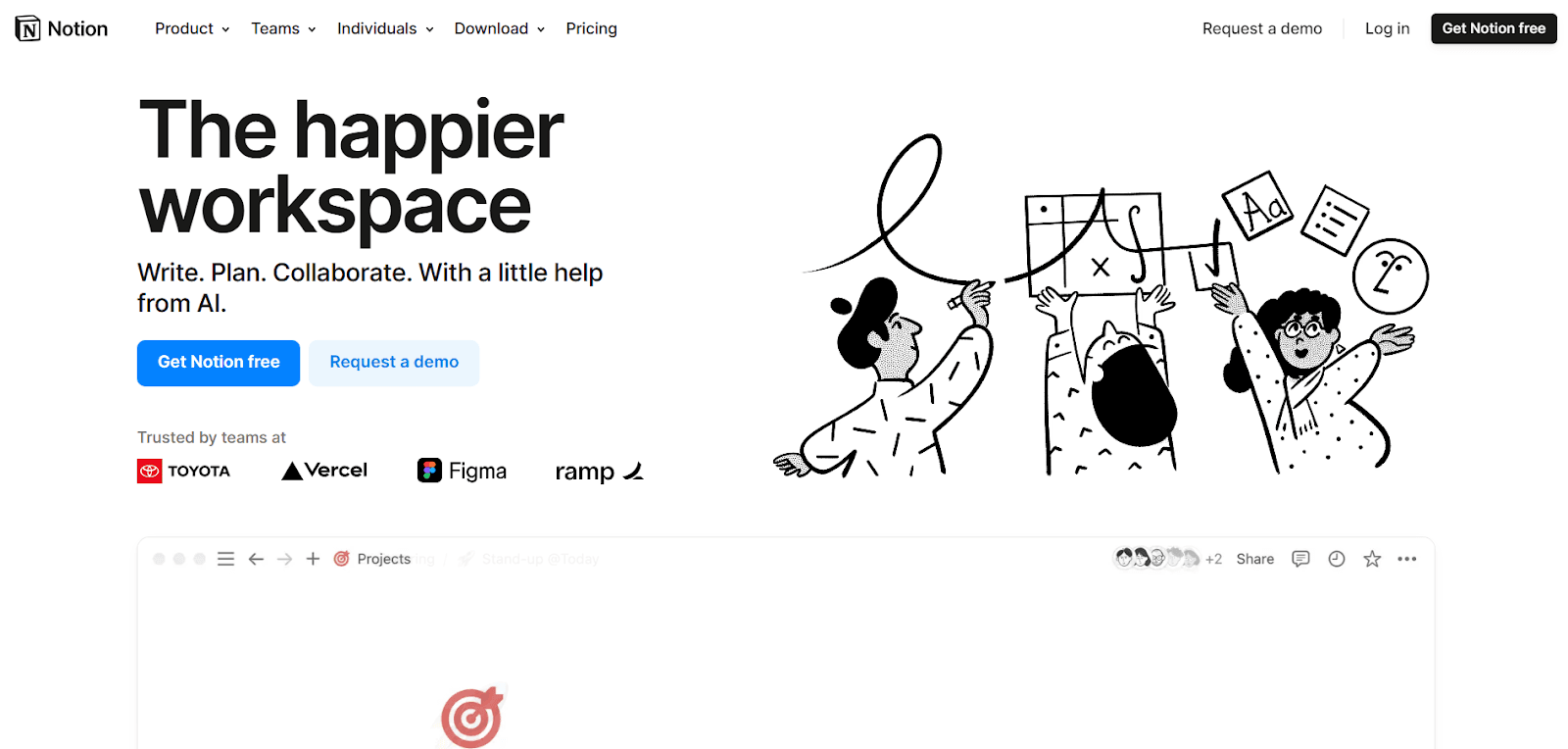
Notion is a database-driven note-taking app that provides a high level of customization, allowing students to structure their study materials exactly how they want. It combines note-taking with project management, making it a good tool for organizing notes, assignments, and study schedules in one place. With powerful collaboration tools, Notion is also useful for group projects and shared research.
Key Features
Blocks and databases: Organizes notes using tables, wikis, and Kanban boards for a structured study system.
Multimedia support: Adds images, videos, equations, and embedded links to enhance note-taking.
To-do lists and study planners: Tracks assignments and revision schedules to keep students on top of deadlines.
Collaboration tools: Enables easy sharing of notes and projects with classmates for group work.
Knowledge Base Creation: Enables students to build a personal knowledge repository, storing notes, resources, and research materials for future reference.
Best For
Students who prefer a structured and customizable note-taking system.
Those who need a collaborative platform for group work and shared study materials.
Cons
The interface has a learning curve and may feel overwhelming at first.
Limited offline functionality can be an issue for students needing access without an internet connection.
Pricing
Free plan.
Plus: $10/seat/month
Business: $15/seat/month
Enterprise: Custom
5. Obsidian – Best for Power Users and Research-Heavy Subjects

Obsidian is a markdown-based note-taking app designed for students who need to build complex knowledge structures. With an emphasis on interlinking ideas, it helps students create interconnected notes and visualize concepts through its graph view. It is particularly useful for STEM students, researchers, and those working on long-term academic projects.
Key Features
Linking Notes: Creates connections between notes using internal links, allowing students to build a web of ideas that’s easy to navigate and explore.
Graph View: Visualizes how notes are connected, giving students a comprehensive map of their thoughts and ideas.
Advanced formatting support: Includes Markdown, math equations, and code snippets for technical and structured notes.
Highly customizable with plugins: Helps expand functionality with features like mind maps and Kanban boards.
Offline access: Provides complete control over stored data without relying on cloud services.
Plugin Ecosystem: Offers a variety of plugins to extend functionality, such as calendar integration, task management, and even advanced search features.
Best For
STEM students and researchers who need to manage large volumes of interconnected information.
Those who prefer a highly customizable and locally stored note-taking system.
Cons
Set up and usage may require some technical knowledge to use effectively.
Those working on long-term research or knowledge-building projects.
Lacks built-in collaboration features, making it less suitable for group work.
Pricing
Free for personal use.
Commercial: $50/user/year
6. Bear Notes – Best for Structured Note-taking With Markdown
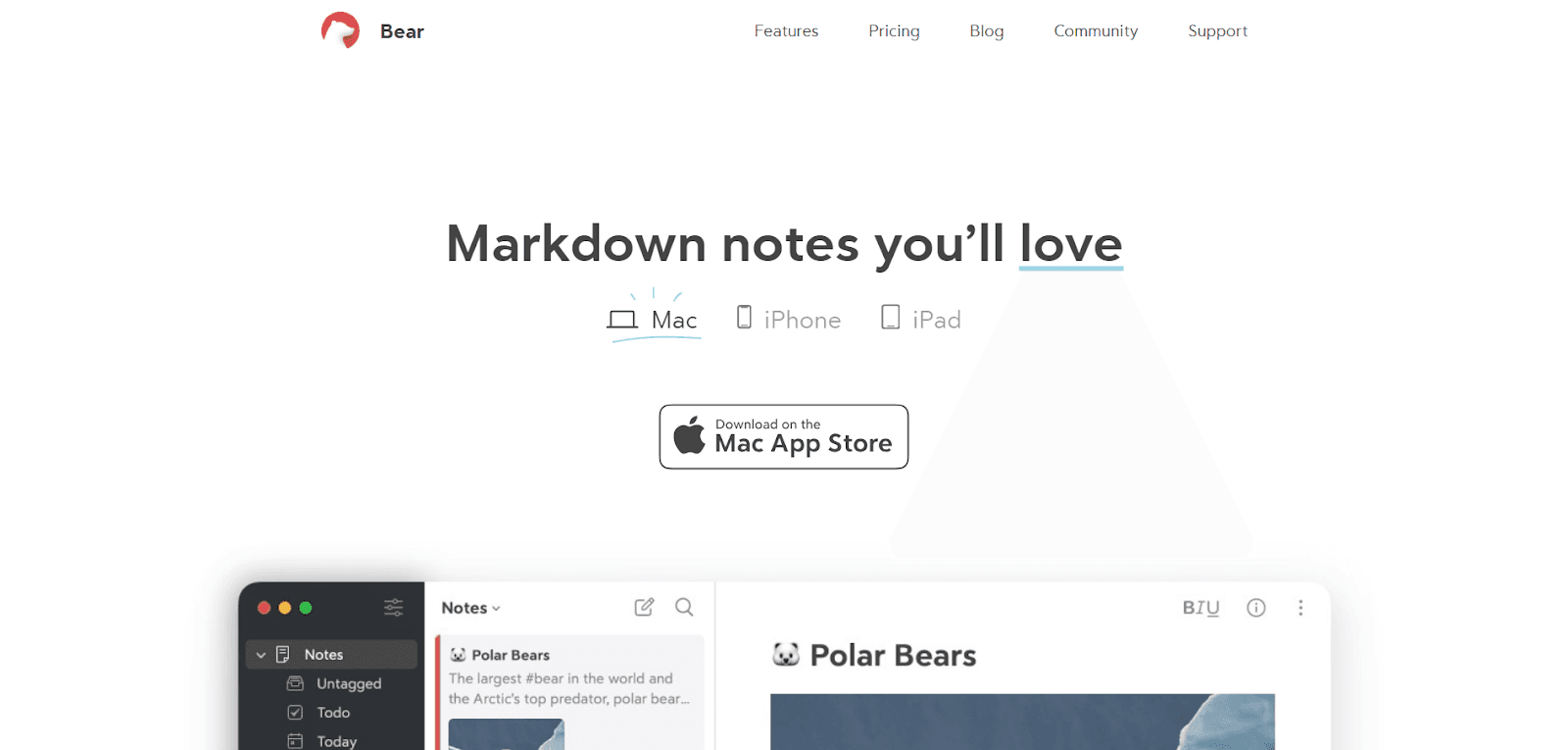
Bear Notes is a minimalist note-taking app designed for college students who need a distraction-free writing environment with advanced organizational tools. It supports Markdown formatting, making it ideal for structuring lecture notes, research summaries, and essays.
Instead of traditional folders, Bear Notes uses hashtags and nested tags, allowing students to categorize and retrieve notes efficiently. With cross-device syncing between iPhone, iPad, and Mac, students can seamlessly switch between devices while working on assignments or reviewing class materials.
Key Features
Markdown support: Helps students structure notes efficiently using headings, lists, and formatting tools.
Hashtag-based organization: Allows flexible note categorization instead of rigid folder structures.
Cross-platform syncing: Ensures seamless access to notes across iPhone, iPad, and Mac.
Advanced formatting options: Supports to-do lists, tables, and embedded images for enriched note-taking.
Best For
College students who prefer structured note-taking with Markdown.
Those who need an organized system using hashtags and nested tags instead of traditional folders.
Students who work primarily on Apple devices and need seamless syncing across iOS and macOS.
Cons
No support for Windows or Android, limiting cross-platform accessibility.
Lacks collaboration features, making it less ideal for group projects.
Pricing
Free Plan
Pro Plan: $2.99/month
7. Google Keep – Best for Quick Notes and To-Do Lists
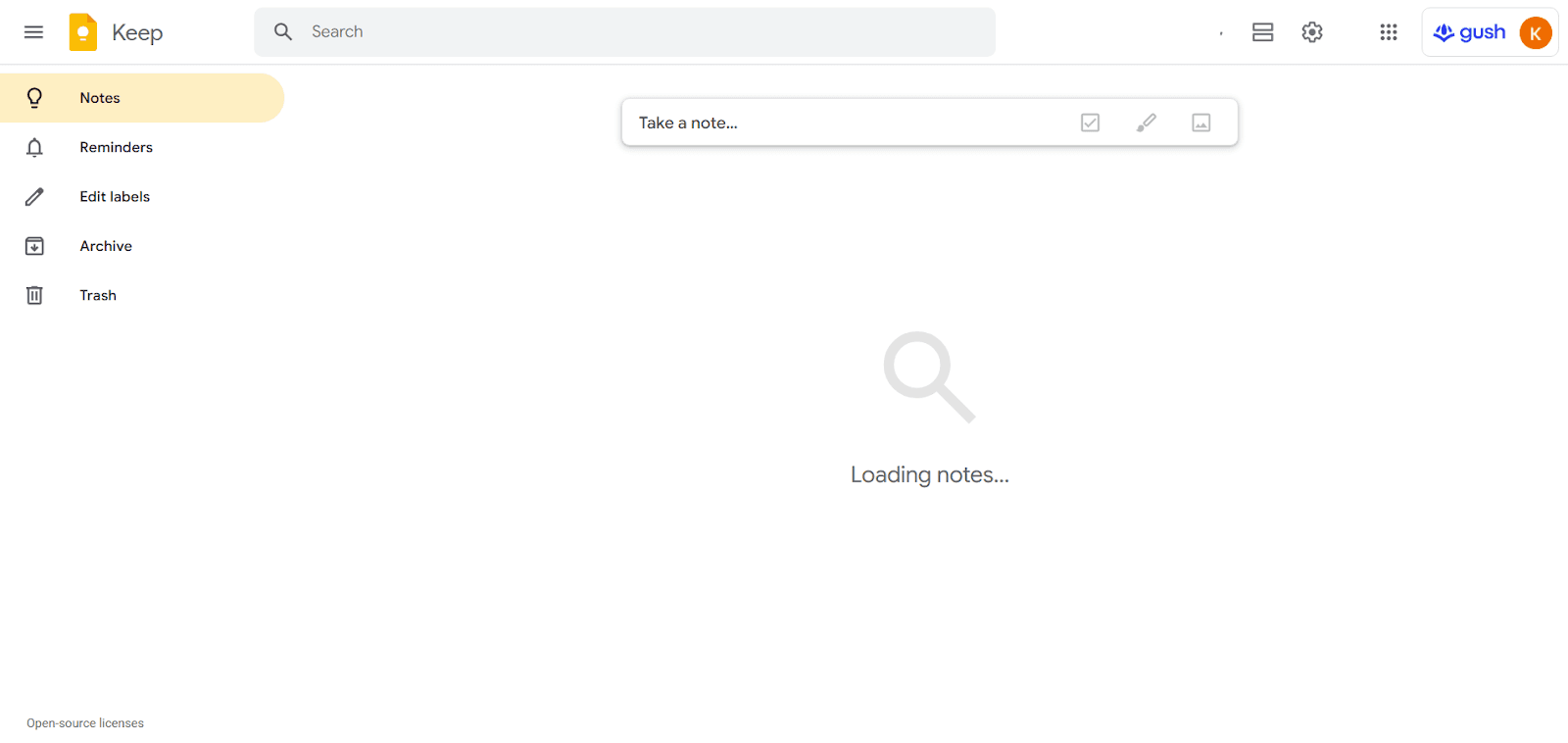
Google Keep is a sticky note-style app designed for capturing quick thoughts, reminders, and to-do lists. While it lacks the depth needed for detailed lecture notes, it excels at short-term memory tasks and organizing simple ideas. Its integration with Google Drive and Google Calendar makes it a convenient tool for students who already use Google’s ecosystem.
Key Features
Color-Coded Notes: Organizes notes with different colors, helping students visually sort and prioritize their tasks, notes, and reminders.
Reminders with time and location trigger: Ensures students never miss an important task.
Syncs with Google Drive and Google Calendar: Keeps notes accessible across all devices.
Voice Memos: Allows students to record and save voice notes, which can be transcribed automatically for easy reference.
Search Functionality: Offers a powerful search function that makes it easy to find notes based on keywords, colors, or labels.
Archived Notes: Keeps archived notes out of sight but still accessible so students can declutter their workspace without losing important information.
Collaborative Notes: Enables real-time collaboration on notes, making it easy for students to work together on projects and study materials.
Reminders: Allows students to set time-based or location-based reminders to ensure important tasks or deadlines are never forgotten.
Best For
Students who prefer a simple, visually organized app for quick reminders and to-do lists.
Cons
Less ideal for in-depth note-taking or long-form content creation.
Limited formatting and organization features.
Pricing
Free (part of a Google account).
8. Simplenote – Best for Distraction-Free Writing
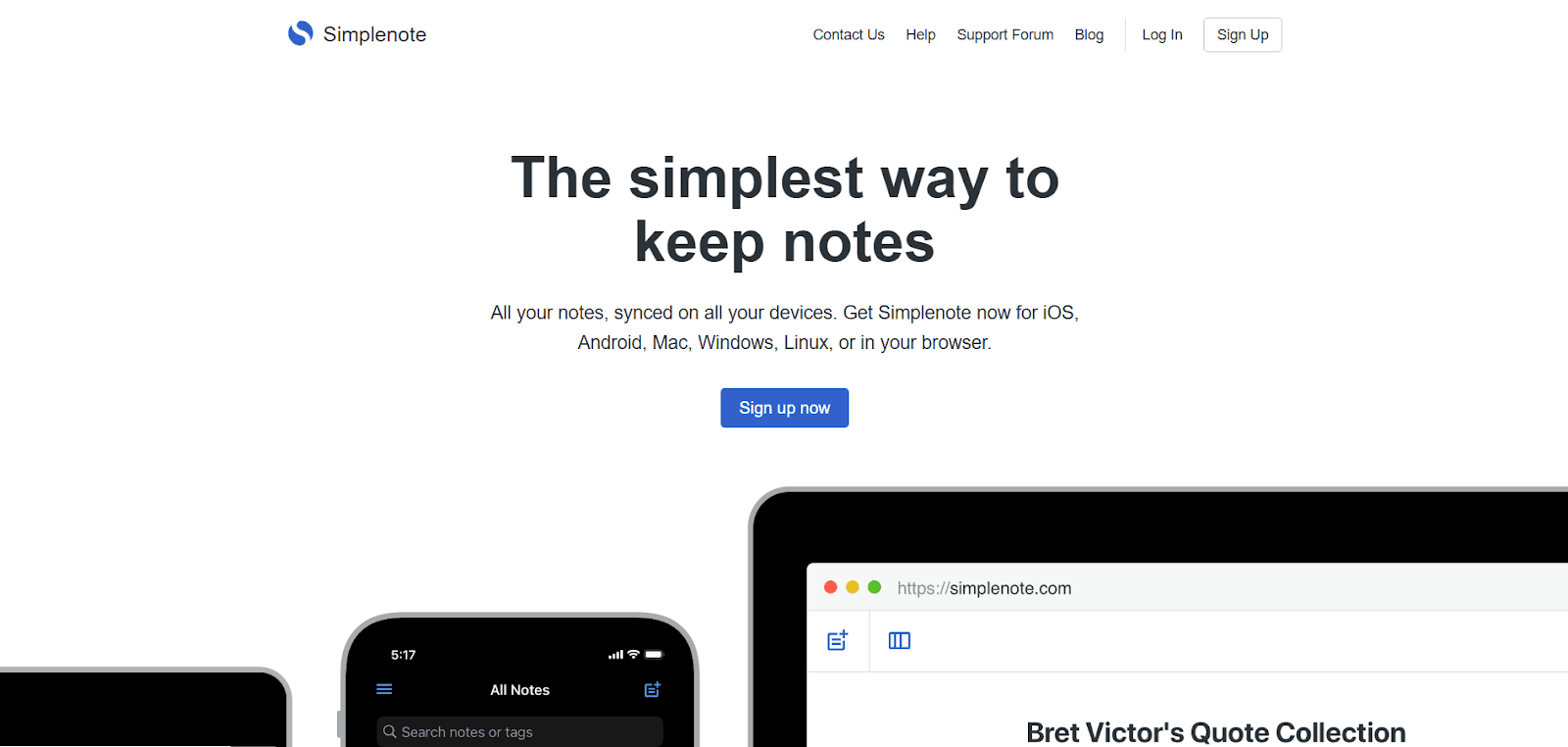
Simplenote is a minimalist note-taking app designed for students who need a clutter-free writing space. It focuses on plain text, making it ideal for distraction-free note-taking and quick organization. With built-in markdown support, it’s also a great option for students who prefer lightweight formatting tools.
Key Features
Tagging: Helps organize notes by adding tags, making it easy to find related content quickly.
Syncs across multiple devices: Works on Mac, Windows, Linux, iOS, and Android.
Search Functionality: Offers a fast and powerful search feature, allowing students to quickly locate specific notes or information.
Version History: Keeps track of note changes, allowing students to access previous versions if needed.
Note Sharing – Allows students to share their notes with peers, making it easy to collaborate or exchange study materials.
Best For
Students who need a fast, distraction-free note-taking app with markdown support.
Those who don’t need advanced features like multimedia support or rich formatting options compared to other note-taking apps.
Cons
Limited project management and organizational tools for students who need more complex note organization.
No rich text formatting, which may limit usability for some students.
Pricing
Free.
Each of these apps serves a similar purpose but caters to different needs. Ultimately, the best note-taking app for you will depend on your unique preferences as a student. Let's now explore how to choose the right app for your needs.
9. Otter.ai

Otter.ai is built for students and professionals who need more than just a blank page to jot notes. It records live conversations, transcribes them as they happen, and even joins your online lectures to take notes for you. It works well with Zoom, Google Meet, and Microsoft Teams.
Its OtterPilot feature goes a step further by handling your entire meeting. From recording and transcription to identifying speakers and summarizing everything with action points, Otter.ai keeps it all in one place. The interface is clean and simple, so you don’t have to be tech-savvy to get started.
Keep in mind, background noise and overlapping speakers can reduce accuracy, and sometimes speaker labels are slightly off. Still, if you're looking for searchable lecture notes and fewer hours spent typing, this one’s worth a try.
Key Features:
Live transcription and searchable transcripts
AI-generated summaries and action items
Identifies different speakers
Works with Zoom, Meet, Teams, Slack, Notion, Google Drive
Can be trained with custom vocabulary
Export files in audio, video, and text formats
Pros:
Easy to use
Saves time during classes and meetings
Strong integrations with other platforms
Flexible export options
Cons:
Accuracy can drop in noisy settings
Speaker labels aren’t always reliable
Pricing:
Free plan available. Paid plans for Pro, Business, and Enterprise users.
Best for:
Students and educators who attend online classes or meetings and want automatic, organized notes.
Platforms:
Web, iOS, Android
Read More: 9 Best Otter AI Alternatives
10. Notta.ai

Notta.ai is great for students dealing with multiple languages or cross-border classes. It transcribes and translates in real time, supporting over 50 languages. The transcription accuracy is solid, and it works with audio or video recordings.
You can also build AI-generated summaries, mind maps, and use pre-built templates for easier studying. If you're someone who prefers learning on your phone, Notta’s mobile experience stands out. The Notta Memo device adds offline transcription if you want to capture things without internet.
Key Features:
Real-time transcription with high accuracy
Translate and transcribe in multiple languages
AI-powered meeting summaries and mindmaps
Sync across all your devices
Import/export audio, video, and text files
Offline transcription via Notta Memo
Pros:
Very fast and accurate
Great for language learners and diverse classrooms
Works well across devices
Strong security and privacy
Cons:
Free plan has some limits
Premium features require payment
Pricing:
Free basic plan. Paid plans start at around $8.17/month.
Best for:
Students who want real-time transcription, translation, and mobile access on the go.
Platforms:
Web, iOS, Android
11. Granola

Granola keeps things private and simple. Instead of using a bot that joins your classes, it captures audio directly from your device. This makes it less awkward in group calls and better for solo learners.
When you start a class, a small popup reminds you to start recording. The app then transcribes the audio and gives you a clean summary with action items. There’s no need to share call access or deal with complicated setups.
However, if you like deep analytics or integrations with other apps, Granola may feel too basic.
Key Features:
Transcribes audio from your device without joining the call
Pops up automatically when meetings start
Generates AI-based summaries and to-do items
Works across all major meeting platforms
Privacy-first (doesn't require access to your calls)
Pros:
No bots in your meetings
Smooth and minimal design
Great for quick transcriptions
Free trial includes up to 25 meetings
Cons:
Lacks deep analytics and search
Paid plan feels a bit pricey for limited features
Pricing:
Free trial available. Paid plan details on their website.
Best for:
Students who prefer private, no-bot transcription for their lectures or meetings.
Platforms:
Works across different platforms via desktop
12. Google NotebookLM

NotebookLM is a research-focused app from Google that helps you understand your own documents better. You upload files like PDFs, Docs, notes, or YouTube links, and it creates summaries, flashcards, Q&As, study guides, and even podcasts.
It uses Google's Gemini AI to work only with your uploaded content, so everything it generates stays true to your material. While it's excellent for research-heavy subjects, it doesn’t capture live notes and works only on one notebook at a time.
Key Features:
Lets you upload PDFs, Docs, YouTube links, and more
AI turns content into summaries, Q&As, flashcards, and mind maps
Generates timelines and podcasts from long files
All responses are based on your uploaded sources
Powered by Google’s Gemini AI
Pros:
Helps make sense of heavy study material
Free to use
Custom flashcards and summaries
Perfect for deep learning
Cons:
Doesn’t record or transcribe live classes
You can’t use multiple notebooks at the same time
Pricing:
Free
Best for:
Students who need help breaking down and studying complex reading material.
Platforms:
Web
13. Genio (formerly Glean)

Genio is built with students in mind. It lets you record lectures, take notes, and add highlights in a structured way. Later, you can go back, replay parts of the lecture, organize content with headings, and test yourself.
The app is distraction-free and encourages active learning. Many universities also recommend or provide Genio as a tool for students who need learning support. It’s simple for beginners and offers useful features for advanced learners too.
Key Features:
Audio recording with timestamped typed or handwritten notes
Organize by topics, headings, and collections
Highlight and link content
Add tasks, reminders, and test-yourself tools
Works online and offline across devices
Pros:
Keeps notes and audio in sync
Helps you stay organized
Great for reviewing before exams
Easy for beginners, helpful for advanced learners too
Cons
Audio files stay with you (not shareable)
No real-time collaboration
Pricing:
Pricing starts at £12/month.
Best for:
Students who attend a lot of lectures and want a focused, structured way to learn.
Platforms:
Web, iOS, Android, Windows, Mac
14. Apple Notes

If you already use an iPhone, iPad, or Mac, Apple Notes is probably right under your nose. With the latest update, it now offers real-time transcription while you record. You can organize your notes into folders, tag them, add images or checklists, and everything syncs with iCloud. It’s simple, fast, and private.
Key Features:
Live recording with real-time transcription
Supports tagging, folders, and smart folders
Attach documents, images, checklists, sketches
On-device processing for privacy
Syncs across all Apple devices through iCloud
Pros:
Already on your device if you use Apple
Great privacy and fast sync
Easy to use
Clean and minimal layout
Cons:
Only for Apple users
Not as powerful as premium apps for editing
Pricing:
Free with Apple devices
Best for:
Students who already use Apple products and want a simple, secure note-taking tool.
Platforms:
iPhone, iPad, Mac, Web (via iCloud)
15. Zoho Notebook

Zoho Notebook is a good-looking, flexible app that’s great for students who like to organize things their own way. You can create different types of notes using cards such as text, checklists, audio, sketches, or images, and organize them in notebooks.
It also offers tools like a web clipper, document scanner, OCR search, and tagging to help you stay organized. The design is smooth and customizable, although real-time collaboration is limited.
Key Features:
Create multiple card types: text, audio, image, checklist, sketch
Document scanner and web clipper
OCR, tagging, geo-tagging
Beautiful covers and unlimited notebooks
Syncs across devices and platforms
Pros:
Visual and flexible
Good for mixed-media notes
Everything is free to start with
Nice design with custom covers
Cons:
Limited collaboration (one user per note)
Can slow down with long notes
Pricing:
Free with optional Pro plan for extra features
Best for:
Students who like organizing content visually and don’t need live collaboration.
Platforms:
iOS, Android, Windows, Mac, Web
16. Standard Notes

Standard Notes is built for privacy. It’s simple on the surface, but powerful underneath. The free version lets you write plain-text notes, tag them, protect them with passwords, and work offline.
If you want more, the paid version adds rich text, spreadsheets, templates, and more. Everything is encrypted, and syncing across devices is smooth. It’s great for students who care about privacy more than bells and whistles.
Key Features:
End-to-end encryption and password protection
Bi-directional note linking
Offline access with backup and restore
Unlimited syncing across devices
Supports Markdown and custom editors (paid)
Journals, spreadsheets, tags, and templates (paid)
Pros:
Keeps your data safe
Minimalist and distraction-free
Works on every device
Free version is strong
Cons:
Advanced features need the paid plan
Not much focus on design or teamwork
Pricing:
Free version available. Paid plans start around $9.99–$12/month.
Best for:
Students who value security and minimal design while keeping everything synced and private.
Platforms:
Web, iOS, Android, Windows, macOS, Linux
How to Choose the Best Note-Taking App for Students?
With so many options out there, it can be hard to decide which app suits your needs. Here’s a guide to help you choose the best note-taking app for your college life:
1. Consider Your Learning Style
Different students learn in different ways. Some may prefer visual aids, while others learn better through written text. Choose an app that supports your preferred learning style:
Visual learners: Look for apps with strong support for images, diagrams, and multimedia.
Auditory learners: An app like Audionotes with speech-to-text or audio recording features might be ideal.
Kinesthetic learners: Apps that support handwriting or touch input could be a good fit.
Consider your learning style when choosing a note-taking app, as it can greatly enhance how effectively you absorb and retain information.
2. Cross-Device Syncing
College life is busy, and you may need to access your notes from different devices, whether it's your laptop during class or your phone while commuting. Make sure the app you choose syncs across multiple devices seamlessly. Most popular note-taking apps offer cloud syncing, but always check if they support all your devices.
Here you can check more note-taking apps for Mac.
3. Organization Features
Organizing your notes is crucial for easy access and retrieval. Look for apps that allow you to:
Create folders or notebooks for different subjects or projects
Tag notes for easy categorization and searching
Highlight or mark important information for quick reference
Choose apps with features like folders, tags, and highlighting to keep your notes structured and easily accessible.
4. Collaboration Features
Collaboration is essential for group projects or sharing notes with classmates. Opt for apps that offer easy note-sharing, real-time collaboration, and comment features to enhance teamwork and communication.
5. Search Functionality
A robust search feature is essential for quickly locating specific information in your notes. Make sure the app you choose lets you search through typed, handwritten, and audio notes, with options to filter by keywords or tags.
6. Integration with Other Tools
Many students use additional tools for scheduling, task management, and research. Check if the note-taking app integrates with other tools you already use, such as Google Drive, Notion, or Trello.
7. Offline Access
Sometimes, you may not have internet access, especially during commutes or in class. Look for apps like Audionotes that allow you to work offline and sync your changes once you're back online.
8. Price and Budget
Many note-taking apps offer both free and paid versions. The free versions are often quite good, but paid versions may offer additional features like more storage, advanced formatting options, or team collaboration tools. Make sure the app you choose fits within your budget.
9. User-Friendly Interface
A simple, clean interface is crucial for a smooth note-taking experience. Choose an app that is easy to navigate, with tools and features that don’t overwhelm you. Look for an intuitive design that allows you to focus on your notes, not on figuring out how the app works.
10. Security and Privacy
Your notes may contain sensitive information, so it's important to choose an app that ensures your data is secure. Make sure the app offers encryption and password protection options.
By considering these factors, you’ll be able to find the best note-taking app that fits your personal study habits and helps you stay organized and productive throughout your college years.
Conclusion
Effective note-taking plays a key role in managing coursework, staying organized, and preparing for exams. Whether you need AI-powered automation like Audionotes, a structured notebook system like OneNote, or a minimalist tool like Google Keep, the right app can transform how you study.
If you want a smarter, more efficient way to take notes, Audionotes does the work for you—automatically transcribing lectures, summarizing key points, and even generating flashcards and quizzes. No more scrambling to jot everything down or losing track of important details. Focus on learning while Audionotes keeps your lecture notes structured and ready for revision.
Try AudioNotes free today and take control of your study process! Available on iOS, Android, and the web for your convenience — download now!

